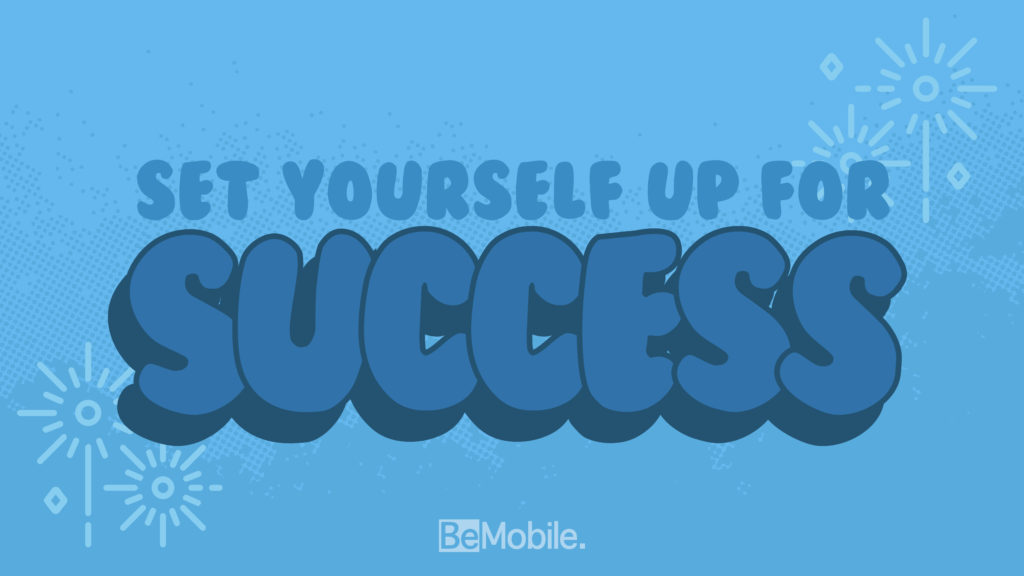
Set yourself up for success with expert advice on creating goals you can actually achieve.
Let BeMobile get you the right device for your goals!
There’s no doubt that January 1 can feel like an inspirational time—the resetting of the calendar can make nearly anyone feel ready to make changes in their lives and turn over a new leaf. But if you’ve ever embarked on an ambitious New Year’s resolution only to feel burnt out by mid-January, you’re not alone. In fact, research shows that nearly two-thirds of those who set resolutions give up within the first month.
This isn’t because our goals are doomed to fail, but because we often set them without a plan for how we’re going to achieve them. Not sure if your resolution is realistic? Follow these seven tips for setting an achievable New Year’s resolution and working toward your goals for long-term change.

1. Start with a positive outlook
As with most goals, you’ll have the greatest chance of having your New Year’s resolution stick if you approach it believing you will succeed. “The dawning of a new year is always going to bring with it thoughts of doing better or more than the year before, so why not ride that momentum wave and set some goals and intentions?” says Tami Smith, a certified personal trainer. “It’s a fresh start if you choose to see it that way.”
But your initial attitude around your resolution can affect your results. Going into the new year with an optimistic outlook instead of a self-punishing attitude can help you feel ready to tackle the new year.
“New Year’s resolutions can easily fail if they’re too vague and if they’re created from a place of shame or regret,” says Laura Athey-Lloyd Psy.D., a licensed clinical psychologist and founder of Reflection Psychological Services. “Resolutions such as ‘lose weight,’ or ‘spend less money,’ broadly imply that we already think we have been failing in these areas in the past years. Try reframing those statements into something future-oriented, positive, and concrete.”

2. Be patient with your progress
It’s common to go all-in on a New Year’s resolution with hopes of immediately putting a stop to all bad habits. But this typically results in making unrealistic and unsustainable goals and the impulse to give up altogether the minute you slip up.
“I ask people to really take time to consider what it is that they want to achieve, to have some grace and patience with themselves, and to be realistic,” Smith says. “In order for your resolutions to stick, you need to come into them with the expectation that you’re going to be changing your lifestyle for good, not for a short period of time where you’ll inevitably go right back to your old habits as soon as your goal is achieved.”
Ponder why you want to set your resolution and what completing it will mean to you. Smith recommends writing down your thoughts with pen and paper so you can revisit them all year long. You should also consider what equipment or tools you’ll need to achieve it, if you have someone to help keep you accountable, and how you can break your resolution down into small, measurable steps (more on this coming).

3. Be smart with your goal setting
While it definitely helps to be practical when setting your resolution, the acronym “SMART” can help you design an achievable goal. SMART stands for specific, measurable, attainable, relevant, and time-bound—here’s what that means:
- Specific: Being detailed about setting your goal and coming up with a thorough plan to accomplish it.
- Measurable: Having a way to evaluate your progress and designing concrete steps you can take to be successful.
- Attainable: Setting a goal you have the means to achieve.
- Relevant: Assessing how realistically you can commit to this goal, or if other projects or stumbling blocks may interfere.
- Time-bound: Setting a deadline or interim deadlines as check-ins and ensuring they’re realistic.
If you have a resolution in mind but it feels too broad or ambitious, run through the SMART acronym and see if you can fine-tune it. For example, instead of saying, “I want to eat healthier,” you could say, “I want to try one new healthy vegetable recipe a week.”
“Map out exactly what you want to achieve and then make a manageable plan to execute,” Smith says.

4. Make sure you have your tools in place
Before January 1 rolls around, gather all that you’ll need to achieve your resolution. If your goal is to start lifting weights, invest in a pair of dumbbells. If your goal is to stop using your phone before bed, consider whether you need a lock box. Whatever your resolution is, ensuring you have the equipment needed ahead of time can help you start off on the right foot.
If you’re goal is to achieve better health and wellness then you would benefit from BOGO on select SmartWatches!

5. Take small steps
When trying to form lasting healthy habits, it can help to start small. For example, say your goal is to go to read more, but you’re always on your phone or tablet. Start by reading for 10 minutes each day on your FREE tablet. These smaller changes will make the transition easier and you’ll be more likely to feel good about your progress, and thus accomplish your end goal.
“You are a lot more motivated to keep working on a resolution if you are frequently checking off smaller items on a to-do list than if your lack of progress is hanging over you,” Athey-Lloyd says.

6. Prepare for the worst
It may sound counterintuitive, but preparing for failure may help you reach your goals.
“Sometimes what we see is a self-fulfilling prophecy, whereby resolutions fail because once we begin to procrastinate or get stuck, we feel so much shame about the possibility of failure, that we then give up entirely,” Athey-Lloyd says. “To stay motivated, accept ahead of time that setbacks are inevitable and make a plan for how you will overcome them. List in advance a few actionable steps you will take if you get off course—it’s easier to think clearly now, before you are actually in that defeatist moment.”

7. Set up safety nets for accountability
A practical resolution will be easier to achieve, but it still doesn’t come without hard work. When things get tough, focus on your “why” as well as how good your newfound habits make you feel. “Know that you will absolutely stumble and fall during your journey: No one is perfect,” Smith says. “Don’t use a slip-up as an excuse to throw it all away. Get right back on track when you’re able.”

Another simple tactic for accountability is to talk to a friend or family member about your resolution—just saying your goal out loud can boost motivation. You might also find someone you know has resolutions they need help keeping, and you can support each other when the going gets tough. “[Your accountability buddy] doesn’t even need to be working on the same resolution as you are,” says Athey-Lloyd. ”The most important thing is that you share your resolutions with one another and check back in with each other at planned intervals.”
It may also help to have a way to track your progress, as being able to visualize your achievements can help you stay motivated. For those with a fitness goal, a fitness tracker or smartwatch can help keep tabs on your activity levels. You can also keep an old-fashioned paper journal to record and reflect on your journey.
Should your resolution feel overwhelming or unachievable after you get started, don’t give up. It’s never too late to pivot and start with a new set of goalposts. Athey-Lloyd explains: “You absolutely do not have to wait until next January to regroup. In fact, one real problem with New Year’s resolutions is that we associate them so strongly with this time of year that we lose sight of the potential to make change in our lives at any time, and needlessly postpone what we could begin on any day. If you keep getting stuck, take some time to assess: Was your resolution too broad, vague, or weighed down with shame? Assign yourself a small, easily achievable first step to get your momentum back.”

